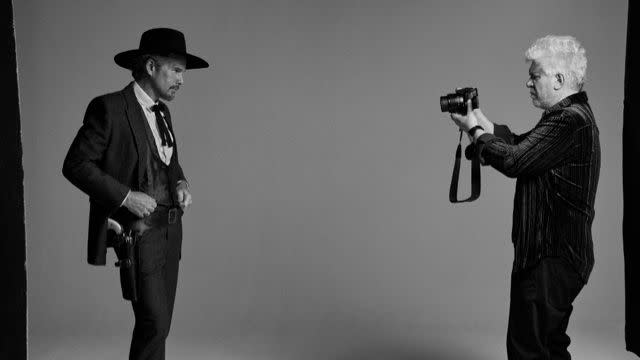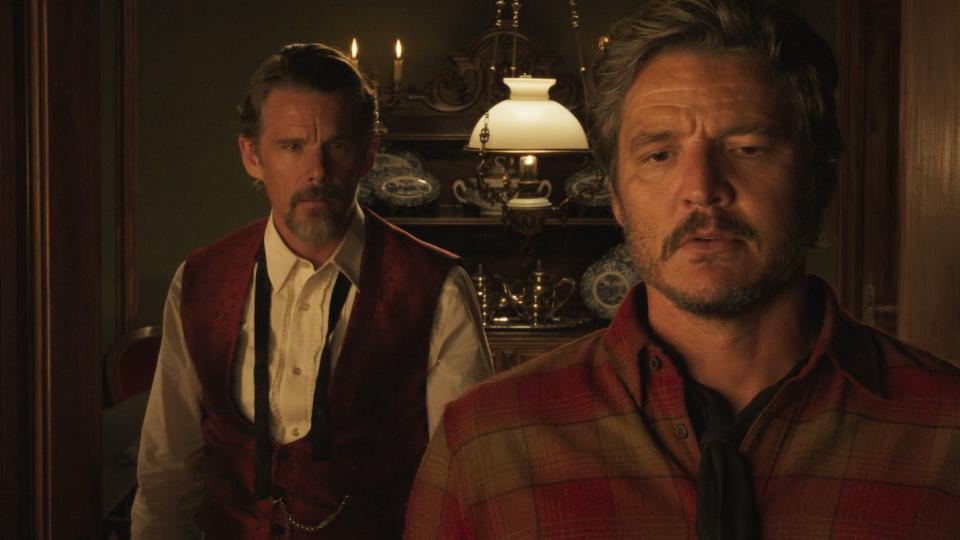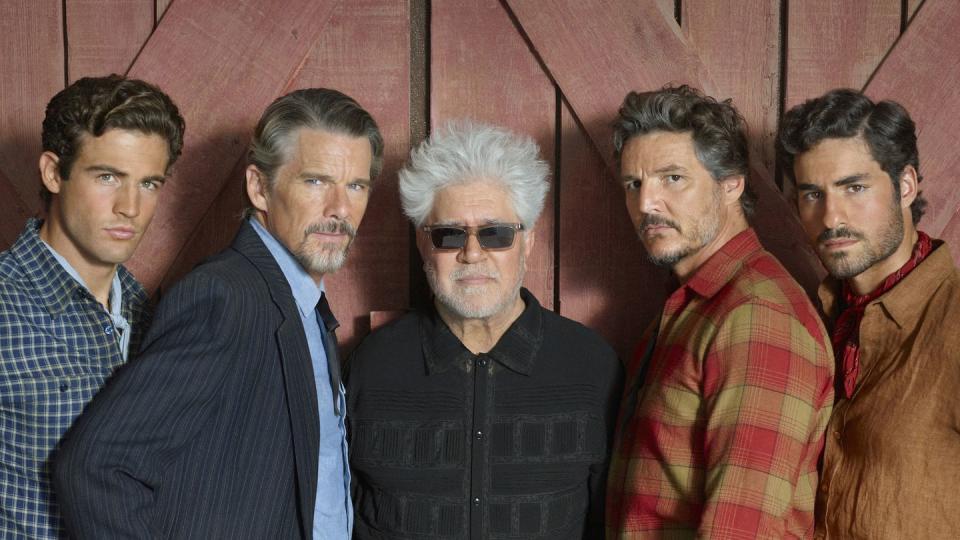Pedro Almodóvar Remains in a League of His Own

- Oops!Something went wrong.Please try again later.
For more than four decades, Pedro Almodóvar, the prolific Spanish auteur, has both shocked and delighted audiences with his bold, playful, and transgressive approach to filmmaking, bringing an artistic flair to his provocative stories about the inner lives of modern women and his deeply human portrayals of gay and transgender people.
Blending genres to create a cinematic style that remains largely his own, Almodóvar rose to international prominence with Women on the Verge of a Nervous Breakdown (1988) and won two Academy Awards, for All About My Mother (1999) and Talk to Her (2002). In the last two decades, he has cemented his status as a modern master of Spanish cinema, garnering critical acclaim for titles such as Bad Education (2004), Volver (2006), Pain and Glory (2019), and Parallel Mothers (2021).
In recent years, however, Almodóvar has directed his attention to making English-language films. After adapting Jean Cocteau’s one-act play The Human Voice into a short film, which stars Tilda Swinton as a woman grappling with the abandonment of her ex-lover, Almodóvar’s latest outing is an unabashedly queer take on the western genre. A Sony Classics Pictures short that premieres in theaters today, Strange Way of Life tells the story of a sheriff (Ethan Hawke’s Jake) and a cowboy (Pedro Pascal’s Silva) who reunite 25 years after working together as hired gunmen and having a passionate affair.
On a recent trip to premiere Strange Way of Life at the 61st New York Film Festival, Almodóvar—who celebrated his 74th birthday last week—sat down with Harper’s Bazaar to discuss how his latest short film explores the desires of middle-aged men, the qualities he looks for in a muse, why he is afraid of getting older, and the surprising genre in which he would like to make a film about the Spanish Civil War.
In Brokeback Mountain, a film you famously turned down to direct because you felt you wouldn’t be able to have complete artistic freedom and independence, Heath Ledger’s character asks, “What would two men do in the West, working on a ranch?” You answer that question in Strange Way of Life: “They can look after one another. Protect each other. They can keep each other company.” With that answer in mind, how did you approach writing and directing this short film?
This is the first time that I approached a genre like a western, and it’s a genre that doesn’t belong to my culture. I’m very eclectic in my movies. You can see how I mix different genres, and for me, it’s something natural. This is the way that I conceive the stories. But in this case, I tried not to make any anachronism, and this is the first time [that’s happened], because I don’t do that in my other movies. [Laughs.]
I took the advantage of saying something that I didn’t find in other westerns, in a genre that is crowded with male characters, which is to talk about a man’s desire. Two men couldn’t say this kind of dialogue [back then], but I really like to put naked the words they say about their desires because it is very unusual not only in the western genres, but even in a drama. With very few exceptions like [writer-director] Ira Sachs, for example, in Passages, it's unusual that two mature men talk about their own desires. So this is something that I specifically wanted, and this is the reason for the movie to exist.
Given that you are known for your meticulousness and attention to detail as a filmmaker, what did you discover in the rehearsal process with Pedro and Ethan that allowed you all to build on the dynamics that you had written on the page? How did you wind up casting them as your leads?
When I contacted Ethan and Pedro, I knew both of them in advance. I sent them the script, they loved it, they wanted to work with me. It was really quite easy to work with them. [There] was a week that we had to adapt to each other because I used to rehearse a lot, and they don’t make so many rehearsals. So we agreed to do some because then I’m much more quiet if I know exactly what is going to be in front of the camera. [Laughs.] But it’s true that when they were in front of the camera, they were much better than I thought and much better than when we were rehearsing, and I didn’t have any problem with them.
I wanted two actors that belonged to very different cultures—Ethan is from Texas and Pedro is from Chile, from Latin America—because the characters were like that. Their characters were physically very different and [differed] in the way they feel about their own desires, in the way they talk about what happened the night before. [Pedro and Ethan] understood this very well, and we didn’t have any kind of problem. We didn’t have this kind of intimacy coordinator, and we didn’t need it. The younger actors [José Condessa and Jason Fernández] also didn’t have any problem doing what they do. So, for me, it was a lot of fun to listen to them in this piece that is very theatrical.

There has always been something lustful, carnal and animalistic about many of the intimate scenes in your films, and this short film is full of these little moments of sexual tension without being sexually explicit, such as the brief touches and long glances. How did you want to challenge traditional depictions of intimacy and sexuality in this genre?
Yeah, this is something that I decided [to do] since the very beginning. I was very explicit in my movies in the ’80s and in the ’90s, so it’s not a question of if I dare to do that or not. I did it already! I decided not to strip the bodies, but to use bare words and also the way [the characters] look at each other. Strange Way of Life, I think, is very erotic and very full of sensuality, but it’s not based in nudity. For example, when they are having dinner, the way that Pedro looks at Ethan, there is a moment that Ethan is so warm that he says, “Please don’t look at me like that.”
I decided that when they are dressing up [the morning after they have sex], they are naked at the beginning and we don’t see the whole bodies, but we see a close-up of two guys [to show] that they are very close. It’s not explicit, but it’s a kind of sensuality that I hope the spectators can feel. Since the beginning, I was more interested in stripping the words, the dialogues, because I didn’t see in many of the westerns that I saw a character like Pedro’s saying, “Ours is a strange fate. It was necessary that the wife of your brother died for us to be together in the same bed.” For me, it was more interesting that one character says this or cures an ailment [than] f–king the whole night. [Laughs.] [I wanted] to be austere and not explicit in showing the bodies but showing the feelings and their intentions—it’s very interesting for me as a narrator.
You’ve become known, among many things, for your collaborations with some of the biggest Spanish movie stars of all time, including Penelope Cruz, Antonio Banderas, Carmen Maura and Rossy de Palma. Are there any specific qualities in your repeat collaborators that stick out to you as a filmmaker? What are the requirements for being an Almodóvar muse?
It is very important not to have any kind of prejudices, and it is very good to have a sense of humor. [It’s important] to be a good comedian and a good dramatic actor—Antonio and Carmen are a good example of that. They can be very funny and immediately moving. And also, [I look for] a kind of beauty, like Penelope, linked with intelligence and instinct and also being photogenic. Sometimes, you put the camera on beautiful people, and they are not so beautiful, so I need to have photogenic [actors]. I also love unconventional faces which are not the canon of beauty. A good example of that is Rossy de Palma. Rossy has a very special face, depending from where you look at her, and [my standard] is to be expressive, not to be beautiful [according to conventional standards]. I love something very specific from the people that are very expressive, and I can use that.

While promoting Pain and Glory in 2019, you said that, after your back surgery, you had to live with the pain of thinking that you were never going to be able to make movies again and realized that you couldn’t live without making movies. Martin Scorsese has talked about how, at the age of 80, he has so many stories he still wants to tell but feels like he is running out of time. Do you also feel that way? Do you think about your own mortality and the legacy you want to leave as a director?
Yeah, I started sooner than Martin Scorsese, because since the last six years, I feel that I think about my mortality every day. And every day I ask myself, how many movies are left that I will do in the rest of my life? I really would like not to have this [question] so present [in my mind] because I don’t think it’s a good influence. The fear is bad, so it’s something that I try to fight. My birthday was a week before, and I’m really frightened about not only getting older physically, but that your new ideas don’t convince you [anymore]. This is a serious issue for me. I ask myself, if there is one moment when I see that what I’m writing is not so new for me, what I will do? Will I keep on writing, or will I leave? I don’t know. It seems to me that I will keep on writing and make a movie that is a reminder of many of my movies before.
When I think, for example, about auteurs that I love like [Federico] Fellini, Fellini was very mature when he was 40, and after that, he kept on making movies that were not like Fellini’s 8½, they were not like Fellini’s La Dolce Vita. They were like Intervista, or The Interview, with Anita Ekberg. It was something small, it was not comparable with his other movies. But to see how [Marcello] Mastroianni and Fellini went to see Anita and how [in Intervista] they screened the famous scene in the fountain [with Mastroianni and Ekberg from La Dolce Vita], I was so moved that, as a spectator, I thought that it was worthy that they were not in the peak of their creative life [but still wanted to keep making movies]. For someone that loves one auteur, I’m trying to feel like that, like the spectators will love to see my movies even when they are not so original as before. But it’s something that concerns me a lot.
Besides directing your first feature film in English, do you have an idea of what you want to create in the years to come? Is there a story or a genre that you still haven’t tackled yet?
I don’t know if I’ll do it, but I would like to talk about the Spanish Civil War but in a horror movie—a horror movie really belonging to that genre, not to the war genre. I have some ideas, but I don’t know if I will get it or not.
I want to see what an Almodóvar horror film could look like. That is something that I didn’t know I wanted, but now that you’ve put it out into the universe, I really need you to make this now.
Well, I did something close to the genre, which is The Skin I Live In, but it was not a horror movie. This is something that I really would like to do in the future, and I hope you’ll love it. [Laughs.]
This interview has been edited and condensed for length and clarity.
Strange Way of Life is out now in theaters.
You Might Also Like

